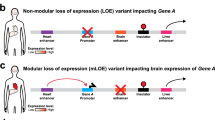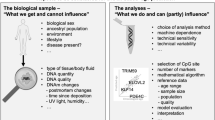Abstract
A total of 27 fragile X pedigrees consisting of over 100 nuclear families were analyzed by Southern blotting methods and probes StB12.3 and StB12.3xx to detect the expansion of the (CGG) n repeat within the FMR-1 gene and the abnormal methylation pattern of the adjacent DNA region responsible for the fragile X syndrome. Clinical expression was found to be associated with the presence of a full mutation (Δ > 500 bp, associated with abnormal methylation) in all the males and 50% of the females studied, whereas individuals carrying a premutation (Δ = 100–700 bp) were normal. A preferential size increase in the enlarged (CGG) n repeat was detected in successive generations, the instability being stronger when transmitted from a female than from a male. No expansion of the premutation to the full mutation occurred in the paternal transmissions, and the size increase was significantly smaller than in the maternal transmissions. This could partly explain the stability of the premutation through several generations in families with transmitting males. In the maternal transmissions, the risk of expansion of a premutation to a full mutation appeared to depend on its size. The critical maternal premutation size leading invariably to the full mutation was between Δ = 175–200 bp. This is important for genetic counseling and also explains the commonly observed clustering of affected individuals in fragile X families.
Similar content being viewed by others
References
Carpenter N, Swartz-Boyd J, Prichard J, Lam T (1992) Linkage and risk assesment in fragile X families using new DNA probes at Xq27. Am J Med Genet 43:312–319
Emery A (1976) Methodology in medical genetics. An introduction to statistical methods. Churchill Livingstone, Edinburgh London New York
Fu YH, Kuhl D, Pizzuti A, Pieretti M, Sutcliffe J, Richards S, Verkerk A, Holden J, Fenwick R, Warren ST, Oostra BA, Nelson D, Caskey CT (1991) Variation of the CGG repeat at the fragile X site results in genetic instability: resolution of the Sherman paradox. Cell 67:1047–1058
Hansen RS, Gartler S, Scott CR, Chen S-H, Laird C (1992) Methylation analysis of CGG sites in the CpG island of the human FMR1 gene. Hum Mol Genet 1:571–578
Heitz D, Devys D, Imbert G, Kretz C, Mandel J-L (1992) Inheritance of the fragile X syndrome: size of the fragile X premutation is a major determinant of the transition to full mutation. J Med Genet 29:794–801
Kremer EJ, Pritchard M, Lynch M, Yu S, Holman K, Baker E, Warren ST, Schlessinger D, Sutherland GR, Richards RI (1991) Mapping of DNA instability at the fragile X to a trinucleotide repeat sequence p(CGG) n . Science 252:1711–1714
Kähkönen M, Alitalo T, Airaksinen E, Matilainen A, Launiala R, Autio S, Leisti J (1987) Prevalence of the fragile X syndrome in four birth cohorts of children of school age. Hum Genet 77:85–87
Laird C (1987) Proposed mechanism of inheritance and expression of the human fragile-X syndrome of mental retardation. Genetics 117:587–599
Laird C, Lamb M, Thorne J (1990) Two progenitor cells for human oogonia inferred from pedigree data and the X-inactivation imprinting model of the fragile X syndrome. Am J Hum Genet 46:696–719
Lubs HA (1969) A marker X-chromosome. Am J Hum Genet 21:231–244
Nakahori Y, Knight SJ, Holland J, Schwartz C, Roche A, Tarleton J, Wong S, Flint TJ, Froster-Iskenius U, Bentley D, Davies KE, Hirst MC (1991) Molecular heterogeneity of the fragile X syndrome. Nucleic Acids Res 19:4355–4359
Macpherson J, Harvey J, Curtis G, Webb T, Heitz D, Rousseau F, Jacobs P (1992a) A reinvestigation of thirty three fragile(X) families using probe StB12.3. Am J Med Genet 43:905–912
Macpherson J, Nelson D, Jacobs P (1992b) Frequent small amplifications in the FMR-1 gene in fra(X) families: limits to the diagnosis of premutations. J Med Genet 29:802–806
Oberlé I, Rousseau F, Heitz D, Kretz C, Devys D, Hanauer A, Boué J, Bertheas MF, Mandel JL (1991) Instability of a 550-base pair DNA segment and abnormal methylation in fragile X syndrome. Science 252:1097–1102
Pieretti M, Zhang F, Fu YH, Warren ST, Oostra B, Caskey CT, Nelson D (1991) Absence of expression of the FMR-1 gene in fragile X syndrome. Cell 66:817–822
Rousseau F, Heitz D, Biancalana V, Blumenfeld S, Kretz C, Boué J, Tommerup N, Van Der Hagen C, DeLozier-Blanchet C, Croquette MF, Gilgenkrantz S, Jalbert P, Voelckel MA, Oberlé I, Mandel JL (1991a) Direct diagnosis by DNA analysis of the fragile X syndrome of mental retardation. N Engl J Med 325:1673–1681
Rousseau F, Heitz D, Oberlé I, Mandel JL (1991b) Selection in blood cells from carriers of the fragile X syndrome: inverse correlation between age and proportion of active X chromosomes carrying the full mutation. J Med Genet 28:830–836
Rousseau F, Heitz D, Biancalana V, Oberlé I, Mandel JL (1992) On some technical aspects of direct DNA diagnosis of the fragile X syndrome. Am J Med Genet 43:197–207
Sambrook J, Fritsch EF, Maniatis T (1989) Molecular cloning: a laboratory manual, 2nd edn. Cold Spring Harbor Laboratory, Cold Spring Harbor, NY
Sherman SL, Morton NE, Jacobs PA, Turner G (1984) The marker (X) syndrome: a cytogenetic and genetic analysis. Ann Hum Genet 48:21–37
Sherman SL, Jacobs PA, Morton NE, Froster-Isekenius U, Howard-Peebles PN, Nielsen KB, Partington MW, Sutherland GR, Turner G, Watson M (1985) Further segregation analysis of the fragile X syndrome with special reference to transmitting males. Hum Genet 69:289–299
Sutherland GR (1979) Heritable fragile sites on human chromosomes. I Factors affecting expression in lymphocyte culture. Am J Hum Genet 31:753–765
Suthers GK, Mulley JC, Voelckel MA, Dahl N, Väisänen ML, Steinbach P, Glass IA, Schwartz CE, Oost BA van, Thibodeau SN, Haites NE, Oostra BA, Giné R, Carballo M, Morris CP, Hopwood JJ, Sutherland GR (1991) Genetic mapping of new DNA probes at Xq27 defines a strategy for DNA studies in the fragile X syndrome. Am J Hum Genet 48:460–467
Verkerk A, Pieretti M, Sutcliffe J, Fu YH, Kuhl D, Pizzuti A, Reiner O, Richards S, Victoria M, Zhang F, Eussen B, van Ommen GL, Blonden L, Riggings G, Chastain J, Kunst C, Galjaard H, Caskey CT, Nelson D, Oostra BA, Warren ST (1991) Identification of a gene (FMR-1) containing a CGG repeat coincident with a breakpoint cluster region exhibiting length variation in fragile X syndrome. Cell 65:905–914
Väisänen ML, Kähkönen M, Leisti J (1992) Carrier detection of the fragile X syndrome with flanking RFLP markers and linkage analysis. Am J Med Genet 43:307–311
Webb TP, Bundey SE, Thakke AI, Todd J (1986) Population evidence and segregation ratios in the Martin-Bell syndrome. Am J Med Genet 23:573–580
Willems P, Van Roy B, De Boulle K, Vits L, Reyniers E, Beck O, Dumon J, Verkerk A, Oostra B (1992) Segregation of the fragile X mutation from an affected male to his normal daughter. Hum Mol Genet 1:511–515
Yu S, Mulley J, Loesch D, Turner G, Donnelly A, Gedeon A, Hillen D, Kremer E, Lynch M, Pritchard M, Sutherland GR, Richards RI (1992) Fragile-X syndrome: unique genetics of the heritable unstable element. Am J Hum Genet 50:968–980
Author information
Authors and Affiliations
Rights and permissions
About this article
Cite this article
Väisänen, ML., Kähkönen, M. & Leisti, J. Diagnosis of fragile X syndrome by direct mutation analysis. Hum Genet 93, 143–147 (1994). https://doi.org/10.1007/BF00210599
Received:
Revised:
Issue Date:
DOI: https://doi.org/10.1007/BF00210599




